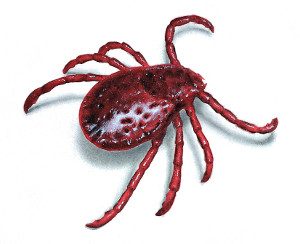Dog Ticks vs. Deer Ticks: A Comparison
Overview of Dog Ticks and Deer Ticks

Dog ticks and deer ticks (aka Blacklegged ticks) are two of the most common species of ticks found in North America. Both types of ticks are known to carry diseases that can be transmitted to humans and animals. However, there are very fundamental some differences between the two species that make us think about them quite differently.
In short……
Appearance
Dog ticks are typically larger than deer ticks, and they have a distinctive lighter-colored shield-shaped plate on their backs. They are usually dark brown or reddish-brown in color and have short, stout mouthparts. In contrast, deer ticks are smaller and have a dark reddish-brown color. Instead of a a shield-shaped plate on their backs they have more of a black patch, and their mouthparts are longer and more slender.
Habitat
Both ticks can be found in many of the same places, but there are some nuances. Dog ticks are commonly found in areas with high grass or dense vegetation, such as wooded areas, fields, and meadows. They are also often found on domestic animals such as dogs, hence their name. Deer ticks, on the other hand, are often found in wooded areas and are commonly associated with white-tailed deer and other wildlife.
Diseases
Both dog ticks and deer ticks are known to carry diseases that can be transmitted to humans and animals. Dog ticks are known to transmit diseases such as Rocky Mountain spotted fever and tularemia. Deer ticks are famously known to transmit Lyme disease, anaplasmosis, and babesiosis.
Identification of Dog Ticks

Dog ticks are a type of tick that commonly infest humans and dogs and other animals. They are also known as wood ticks and belong to the Ixodidae family. Here are some key characteristics that can help identify dog ticks:
Size and Shape
Dog ticks are relatively large ticks, with females measuring up to 1/2 inch in length when fully engorged. Males are smaller, measuring up to 1/4 inch in length. Both males and females have a flattened, oval-shaped body that becomes more rounded when engorged with blood.
If you have ever seen a flax seed, a dog tick looks a lot like one.
Color and Markings
Dog ticks have a distinctive brownish-red color, which becomes darker when they are engorged with blood. They also have a white or grayish-colored shield or scutum on their back, which is a distinguishing feature of this tick species. The scutum covers most of the tick’s body and is larger on females than on males. In addition, dog ticks have short, stubby mouthparts that are visible from above.
Identification of Deer (Blacklegged) Ticks

Size and Shape
Deer ticks, also known as blacklegged ticks, are smaller in size and have a flattened, oval-shaped body. Mature female deer ticks are about 3-5 mm long, while males are slightly smaller, measuring about 2-3.5 mm in length. The larvae and nymphs are even smaller, measuring about 1-2 mm and 2-3 mm, respectively. Because they are so small, the nymphs can be hard to see on your body, and that makes them quite dangerous.
Color and Markings
Deer ticks have a distinct coloration that can help identify them. The body of an unfed adult female deer tick is reddish-brown in color, while males are dark brown or black. After feeding on a host, the body of the female tick swells and turns a bluish-gray color. The nymphs have a similar coloration to the adults, but are smaller in size.
Deer ticks also have distinguishing markings on their bodies. The legs of the deer tick are black and have no white markings. The dorsal shield, which covers the tick’s body, has a unique pattern of black and dark red markings that can help differentiate them from other tick species.
It is important to note that the identification of deer ticks should not be based solely on their size and coloration, especially if a tick has been attached. You can often send the tick in for a quick identification at a number of research universities.
Dog Tick vs. Deer Tick Habitat

Preferred Habitats
Dog ticks and deer ticks have similar preferred habitats, but there are some ways you might expect to find more of one or another in certain areas. Dog ticks are commonly found in yards, grassy areas, and fields, while deer ticks tend to thrive in wooded areas and leaf litter. A pile of old, decaying leaves is like a castle for a deer tick.
Dog ticks are more commonly found in areas where there are domesticated animals, such as dogs, which are their primary host. They are often found in grassy areas, where they wait for a host to pass by so they can attach themselves.
On the other hand, deer ticks are commonly found in wooded areas, where they wait for a passing host, such as deer or mice. They are also commonly found in leaf litter, where they can wait for months until a host passes by.
Because of a deer tick’s preferred habitat and propensity to use mice as a host, using tick tubes can be an effective way to combat them.
Host Seeking Behavior
Dog ticks are known to be more aggressive than deer ticks when it comes to host seeking behavior. They are more likely to crawl up a host’s body in search of a place to attach themselves. If you ever go for a walk in long grass, it is likely that you will have a few dog ticks (wood ticks) crawling around after.
attach themselves. If you ever go for a walk in long grass, it is likely that you will have a few dog ticks (wood ticks) crawling around after.
Deer ticks, on the other hand, are more patient and tend to wait for a host to pass by. They climb up to the top of a blade of grass or other vegetation and wait for a host to brush by, at which point they attach themselves. They can be surprisingly quick to attach once they find the right host.
Deer Tick vs. Dog Tick Health Risks
Ticks are known to transmit several diseases. While both dog ticks and deer ticks can transmit diseases, the severity of the illnesses they cause varies. Lots of research is being done on all of these diseases given the public health threat they pose.

Diseases Transmitted by Dog Ticks
Dog ticks are known to transmit Rocky Mountain spotted fever, a bacterial disease that can cause fever, headache, and muscle pain. In severe cases, the disease can lead to organ failure and even death. Additionally, dog ticks can transmit tularemia, a bacterial disease that causes fever, headache, and muscle aches. Tularemia can also cause skin ulcers and swollen lymph nodes. Although rare, dog ticks can also transmit Lyme disease, which causes fever, headache, fatigue, and a characteristic skin rash.
Diseases Transmitted by Deer Ticks
Deer ticks are best known for spreadingLyme disease, the most common tick-borne disease in the United States and one that is spreading at a scary rate. Lyme disease can cause fever, headache, fatigue, and a characteristic skin rash. If left untreated, the disease can spread to the joints, heart, and nervous system, causing severe complications. It can be both short-term and chronic. Deer ticks can also transmit anaplasmosis, a bacterial disease that causes fever, headache, and muscle aches. In severe cases, anaplasmosis can lead to organ failure and even death.
It is important to note that both dog ticks and deer ticks can transmit diseases to dogs, including Lyme disease, Rocky Mountain spotted fever, and anaplasmosis.
Dog Tick vs. Deer Tick Prevention
Personal Protective Measures
To prevent dog ticks and deer ticks from attaching to the skin, take some basic personal protective measures. These measures include wearing long-sleeved shirts, pants, and socks while spending time outdoors in tick-infested areas. It is also recommended to tuck pants into socks and wear light-colored clothing to easily spot ticks. Additionally, individuals should apply a tick repellent containing DEET to exposed skin and permethrin to clothing.
and socks while spending time outdoors in tick-infested areas. It is also recommended to tuck pants into socks and wear light-colored clothing to easily spot ticks. Additionally, individuals should apply a tick repellent containing DEET to exposed skin and permethrin to clothing.
Environmental Management
Environmental management is another way to prevent tick infestations. This involves reducing tick habitats around the home and yard. To reduce the risk of both dog ticks and deer ticks, keep grass and vegetation trimmed, remove leaf litter and brush, and create a barrier between wooded areas and the yard.
Some basic steps to keep a yard clean, free of rotting vegetation and old piles of leaves and branches can go a long way toward getting rid of ticks in your yard.
In the wilder environments, though, like parks or nature areas, the best bet is going to be to use repellent and check yourself for ticks frequently.






